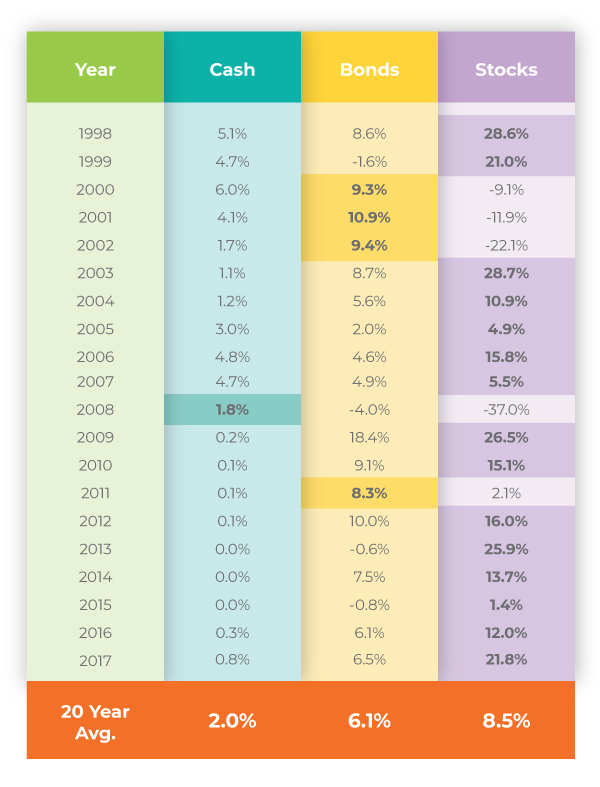According to Yale University’s Crash Confidence Index, only about 27% of investors are confident the stock market will not crash sometime during the next six months.1
But if fear leads investors to avoid the entire investment class, they may limit their potential returns. For example, during the 20-year period ended December 31, 2017, stocks had an average annual return of 8.5%. By comparison, bonds returned 6.1% and cash 2.0% during the same time frame. During that 20-year stretch, stocks outperformed bonds and cash in 14 years out of 20.2
But the stock market is volatile. Between October 9, 2007, and March 9, 2009, the Standard & Poor’s 500 stock index shed well over half its value. But then the S&P 500 started clawing its way back and ended 2010 within 20% of the October 9, 2007, close.3
Tip: Fund Flows. In January 2017, investors added $10 billion to mutual funds, a significant shift from the $56 billion they had taken out of mutual funds the month before.
Source: Investment Company Institute, 2017
If the impulse to be safe keeps investors out of the stock market, it may also keep them from taking advantage of the potential returns the stock market has to offer.
Fast Fact: Fund Owner. Nearly half of U.S. households — 44% — own shares of mutual funds. That’s an estimated 54.9 million households.
Source: Investment Company Institute, 2017
Cash alternatives — the most conservative of the three investment classes — outperformed stocks and bonds only once during the 20-year period.2
A sound investing strategy considers short-term volatility without losing sight of long-term objectives.
A sound strategy can involve diversifying capital between different classes of investments. That way, under-performance in one type of asset may be offset by the performance of another.
Bear in mind, though, that diversification and asset allocation are approaches to help manage investment risk. They do not eliminate the risk of loss if a security price declines. The asset class that performs best one year may not do so the next. Diversifying your holdings among several different investment types and understanding that asset classes can move in and out of favor may help you manage the risk in your investment portfolio.
Changing Lead
The asset class that performs best one year doesn’t necessarily do so the next.2
Yale University, 2018
Thomson Reuters, 2018, for the period December 31, 1997 through December 31, 2017. Stocks are represented by the S&P 500 Composite index (total return), an unmanaged index that is generally considered representative of the U.S. stock market. Bonds are represented by the Citigroup Corporate Bond Composite Index, an unmanaged index that is generally considered representative of the U.S. bond market. Cash is represented by the Citigroup 3-Month Treasury-Bill index, an unmanaged index that is generally considered representative of short-term cash alternatives. U.S. Treasury bills are guaranteed by the federal government as to the timely payment of principal and interest. However, if you sell a Treasury bill prior to maturity, it could be worth more or less that the original price paid. Index performance is not indicative of the past performance of a particular investment. Past performance does not guarantee future results. Individuals cannot invest directly in an index.
Standard & Poor’s Corp, 2017. The high of 1565.15 was recorded on October 9, 2007 and the low of 676.53 was recorded on March 9, 2009. The S&P 500 Composite index (total return) is an unmanaged index that is generally considered representative of the U.S. stock market. Index performance is not indicative of the past performance of a particular investment. Past performance does not guarantee future results. Individuals cannot invest directly in an index.
The content is developed from sources believed to be providing accurate information. The information in this material is not intended as tax or legal advice. It may not be used for the purpose of avoiding any federal tax penalties. Please consult legal or tax professionals for specific information regarding your individual situation. This material was developed and produced by FMG Suite to provide information on a topic that may be of interest. FMG Suite is not affiliated with the named broker-dealer, state- or SEC-registered investment advisory firm. The opinions expressed and material provided are for general information, and should not be considered a solicitation for the purchase or sale of any security. Copyright 2018 FMG Suite.
DISCLAIMER: This website is for informational purposes only and does not constitute a complete description of our investment advisory services or any past performance. This website is neither a solicitation nor an offer to sell securities or investment advisory services except where we are appropriately registered or exempt from such registration. Information throughout this site, whether stock quotes, charts, articles, or any other statement or statements regarding market or other financial information, is obtained from sources which we and our suppliers believe to be reliable. However, we do not warrant or guarantee the timeliness or accuracy of this information. Nothing on this website should be interpreted to state or imply that past results are any indication of future performance. THERE ARE NO WARRANTIES, EXPRESSED OR IMPLIED, AS TO ACCURACY, COMPLETENESS, OR RESULTS OBTAINED FROM ANY INFORMATION POSTED ON THIS OR ANY ‘LINKED’ WEBSITE.






